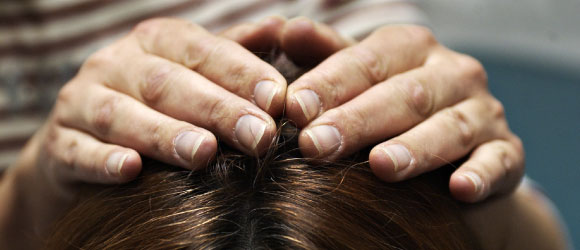Post Concussion Syndrome? How CranioSacral Therapy Can Help

It’s football season again: are you excited? Who’s your favorite team? While football is one of America’s favorite pastimes to watch, (and play), the stress that it puts on the players’ bodies can lead to a lifetime of health problems.
Have you noticed how retired football players move their bodies? You can usually see that they are in some amount of pain, not moving as smoothly or easily as they should be for people their age, right? Even though they have all the resources available to them as athletes, their bodies take a toll from participating in such a rough contact sport.
One of the problems football players encounter that can cause serious, lasting damage is concussions from the number of head shots, bangs on the ground, or quick, violent movements without even hitting the head. When the head sustains this kind of trauma, internal bleeding occurs, and neurons, neuronal centers and glial tissues (which support various brain structures) are damaged.
What occurs from these damages are various issues: behaviorally, athletes with concussions experience irritability, aggression, anxiety, depression, and cognitive dysfunctions like concentration and memory problems. Physically, they may experience headaches, neck pain, dizziness, fatigue, sleep disorders, double vision and more. Other problems that may seem unrelated, like decreased endocrine functions, also may occur.
Sometimes these symptoms don’t show up for a year or more after the concussions, making people wonder why all of a sudden, they are experiencing these things. And with repeated head injuries, these symptoms only become worse.
*Anatomically, the craniosacral system is the deepest layer of the fascial system, a continuous network surrounding every structure of the body. There is even evidence that strands of fascia pierce the cellular membrane and connect to the nucleus of the cell. Tensile strength of the fascial network has been measured up to 7,000 pounds per square inch. These forces, combined with the continuity of the fascia, helps to explain the myriad of symptoms that an individual may experience after an injury should have healed. Post concussion syndrome is one example among many illustrating the effects of a tight fascial system on the other systems of the body. *The Upledger Institute *
So why does the light touch and gentle holds of CranioSacral Therapy work? When working with the craniosacral system at this deepest level of the body, we are be able to release restrictions at a level that physical manipulations can not. The anatomical attachments points of the craniosacral system at the head and various membranes, exiting into the neck and all the way down into the base of the spine, along the spinal column, show the continuity of the fascia and why CranioSacral Therapy has such far reaching effects.
CranioSacral Therapy helps with mobilization of the bones in the head, thus affecting the membranes and the glial network that is attached to the nervous system. Post concussion symptoms have proven to respond well to CranioSacral Therapy, reducing emotional, physical and behavioral symptoms, improving functions and decreasing pain.
Do you know of anyone struggling with Post Concussion Syndrome? Are you? Contact me for a CranioSacral appointment today to help relieve your pain and get you moving and functioning better!
